UPCOMING: June 16-22 2025 ~ (Rotterdam, the Netherlands) :: LIVE in WORM :: HAROLD SCHELLINX Post-Post ULTRA (van 1983 tot en dan almaar verdur) :: (it is all) Politics >:> eternity, unPublic, sudoku's, Commuters, 1024, k7, collage, Gentle Slaughter ... Concert on Saturday, June 21. Drinks on Sunday 22!!
SUBSCRIBE to soundblog_un_public our personal / private old-school email newsletter alternative to the use of FB, X, Insta and other surveilling & exploiting media. Our occasional newsletter brings web links to new and not-so-new thoughts, to releases, concert dates, texts related to projects / works by Har$, the ookoi, other collabs, etc.
[ quicknav-: Applaus! | Signification & Serrealism (sic) | Rites ]
12 mins read 🤓
Full Coloration Set Sudoku Pieces
march 01, 2025
“ Applaus gaat donders goed samen met Eeuwigheid ”
Over the past few weeks I did sudoku solution work in which the chosen sound makers are basically pitchless, like in the initial K7 sudoku's: the sudoku digits are solely read as points in time, the entry points for sounding events, as markers on a timeline. In other works, notably the variations for perished piano, the suso grid provides the graph (architecture) for both entry points, and pitch changes. The contingency of the choices involved there became reflected in a series (variations) obtained by permutations of rows and columns of the initial grid. In the current works, also always based on one single sudoku solution, that contingency is explored through the vast number of possible recolorations of the initital matrix, as earlier on evoked in my description of a Perished Piano Sudoku Dream Machine'.
Applaus ! (suso #8, voor vier klappers)
For « Applaus ! » (suso #8) the sequence of durations is read off sudoku202008, the sudoku solution featured in the eight week's K7 sudoku recording of 2020.  The sudoku digits then are sequentialised ('read') in four different ways: row-by-row, top-to-bottom, right-to-left ; column-by-column top-to-bottom, left-to-right ; row-by-row, bottom-to-top, left-to-right ; column-by-column, bottom-to-top, right-to-left. Each of these four readings provides a clapping part, and together the four (as suggested by the arrows in the image) circle the number grid.
The sudoku digits then are sequentialised ('read') in four different ways: row-by-row, top-to-bottom, right-to-left ; column-by-column top-to-bottom, left-to-right ; row-by-row, bottom-to-top, left-to-right ; column-by-column, bottom-to-top, right-to-left. Each of these four readings provides a clapping part, and together the four (as suggested by the arrows in the image) circle the number grid. 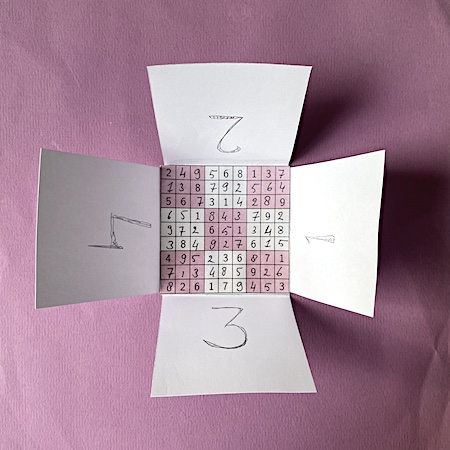 (Or, think of them as different manners to cover the sudoku grid, each a side of a box of which the sudoku grid is the bottom; each side a lid that we can lower so as to cover the grid, see to the right.)
(Or, think of them as different manners to cover the sudoku grid, each a side of a box of which the sudoku grid is the bottom; each side a lid that we can lower so as to cover the grid, see to the right.)
« Applaus ! » is an up-tempo piece: I picked one fifth of a second as the recommended duration for a 'sudoku tick' (a sixteenth note), which makes the duration of a 'run' equal to 81 seconds.
I recorded a number of handclaps on the Zoom, in the bathroom, chose four distinctly sounding ones, and used these to let Sonic Pi 'simulate' the four clappers according to the numbers of suso #8. More so, with just a small twist in the script, I let it loop the runs, each time with a different coloration of the sudoku grid (as explained in some more detail in the previous sudukist text).
This then, is the ideal form of « Applaus ! »: the consecutive 4-piece 'clapping' of all 9! colorations of suso #8, given by the list in lexicographic order of the elements of S9. Adding a short pause of 5.9 second between consecutive runs makes it all add up to a total duration of the piece of very near to exactly 365 days (362880 × 86.904 seconds). Each run will differ from the previous one by a subtle shift in the pattern, due to the swapping of some of the colors, i.e. of the numbers.
As an example, here are a thinkable initial coloration of suso #8 (corresponding to (the identity) permutation (1,2,3,4,5,6,7,8,9)), and its re-coloration according to the second item in the lexicographic list of elements of S9 ((1,2,3,4,5,6,7,9,8)), which just swaps the colors 8 and 9 on the grid.
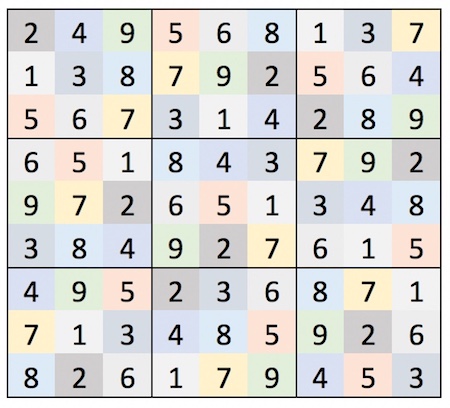 |
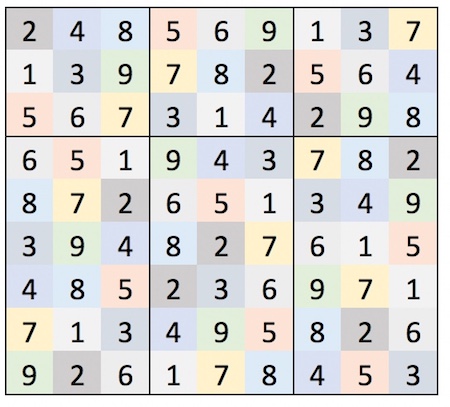 |
And this is how this small change maps to a few correspondingly small shifts in the rhythmic patterns for the four clappers', in the first five measures of the score for each of runs:
| The first five measures of the first round: |
|---|
 |
| The first five measures of the second round: |
 |
Given the complexity of the pattern, to the average ears (including mine), these shifts will be almost imperceptible: one wonders whether the initial 81 seconds four-piece clapping phrase is not simply repeating. However, over time, as the runs evolve (‘mutate‘) in 362880 steps to the final recoloration (the sudoku grid obtained by applying the last element in the lexicographic listing of S9 ((9,8,7,6,5,4,3,2,1)) to suso #8), the shifts and changes in the patterns become substantial:

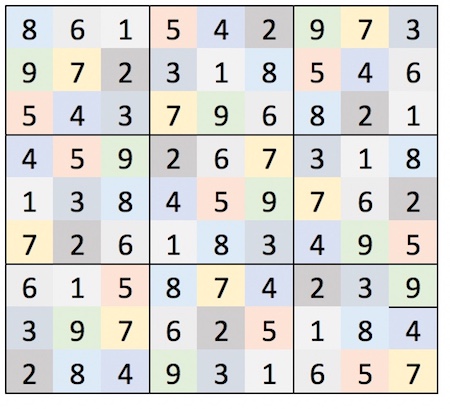
I would be totally happy hearing / seeing « Applaus ! » performed by a quartet of human hand ‘clappers‘, though obviously a 'live' full 365 days 24/7 performance (possible, say, using teams of clappers that are taking turns), seems sort of unlikely to ever happen (to say the least :-). It however is, long as it may be (and arguably beyond our human ability to fully experience), in a way, the piece's ‘natural life time’. (That’s interesting, and worth further reflection.)
However, setting up one or more virtual sudokist clockwork performances as four-channel sound installations, running uninterrupted for a full year in small (public) spaces accessible day and night, would be feasible, no?
The digital album jumps through the year in a 'fast forward' way, picking 87 out of the 362880 runs, at regular distances in the lexicographic list. {{The temporal distance between two consecutive parts on the digital album in a complete and unabridged year-long rendition of the piece would be about 102 hours, so a bit over 4 days.}}
There is also a scored version, explicitly meant for live performance. It is rather short (it will take a little over 8 minutes ((486 seconds)) to perform), consisting in six pairwise (3d)-complementary runs (a notion that is introduced and explained a bit further in this text), the runs corresponding to elements nrs. 1 and 362880, nrs. 90720 and 272161, and nrs. 181440 and 181441. Anyone interested in trying such a live performance, do let me know :-)

Signification and Serrealism (sic)
“What does this tune signify?
What is its meaning?” ( * )
(On February 18th 2025 Ed C. wrote to me: “Can you explain to me the whole “math thing” with the music you do. It does sound like surrealism… Or quarter tone type piano music I’m trying to get the significance, but it’s escaping me.”
“Dear Ed,
I started to use sudoku solution matrices in dictaphone improvisation by a small stroke of serendipity (long ago, in 2006) that at the time I described here in some detail. I continued to use them in live performances for quite some time, until my use of the ‘autoreverse-button’ sudoku technique got interrupted because my SONY TCM 500DV dictaphone died. I only got hold of another 'autoreverse' walkman in 2019, which then inspired the making of the 52 weekly K7 sudoku's in 2020.
There indeed is something ‘surrealistic‘ about the pieces in that series (and about the earlier K7 ones that survived in the chaotic archives of my recordings), though maybe u should name it ‘serrealistic‘: the sudoku grids allow for a ‘repetitive unrepetitivity‘ (a looping of audio fragments ((in the K7-case, of stretches of tape)) that continue to vary in length, but in lengths that are not choosen, but given to me), reminiscent of a 'toy version' of (more or less strict) serialism, of music based on the ‘looping‘ of transpositions of initial series of notes, of tempi, of durations (entry-delays) etc in 20th century academic composition. I liked how this methodology let me ‘wink‘ at the things I learned from Gottfried Michael Koenig in the early 1980s, while at the same time—with its a priori 'givenness' of a totally contingent set of 9 permutations of but 9 digits that leave no room for additional choices, nor for random adjustment—also being something of an antipode.
Besides, sudoku solutions surely are pinnacles of un-meaning.
Of utter in-, of un-significance.
All of the numbers, all the sequences of digits such grids embrace, and that we here refer to, are empty vessels, void of meaning. They are form-al[l], all form, content-less vacuity that resists all attempt at signification. 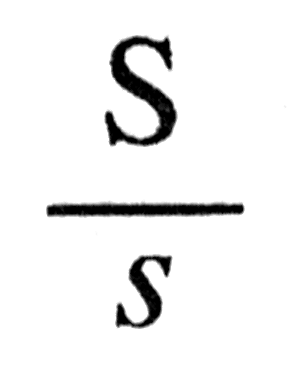 However, in the Lacanian sense, a mind-boggling multitude of signifieds, a maelstrom of meaning, continues ‘to slip and slide underneath‘.
However, in the Lacanian sense, a mind-boggling multitude of signifieds, a maelstrom of meaning, continues ‘to slip and slide underneath‘.
The sudoku's grid imprisons the digits, literally puts them in cells and keeps them ‘in line’. The sudoku thus is phorm (sic), but also meta-phor-m. We can view it as a data tamer, a dipper-down of the persistently growing barrages of data that's bombarding us, built from the 0, 1, 2, 3, 4, 5, 7, 8, 9's, as in a sudoku (the 0, the 'nothing' yet, resides in the empty cells of a not fully filled grid); as an un-binder, a neutralizer of the streams of meant-to-signify numbers that invade and submerge us, and—vice versa—are extracted from us, often in 'forceful' way, stolen from us, taken against our will.
The suso grids and their sequencing make up the skeleton. Meaning emerges from the flesh: the audio events, the sonic images (het klankbeeld) that were grafted on to that skeleton. The act of grafting itself is mostly still a form-al act. Signification happens after, upon hearing, when you are hearing. Any emerging meaning, all sign-ification, is in your ear, the ear of the beholder.
Not sure if this answers your question, but well, here's what it is :-)
Best, ”
Rites (suso #5, for four triangles, tuned gongs and an old clock's chime)
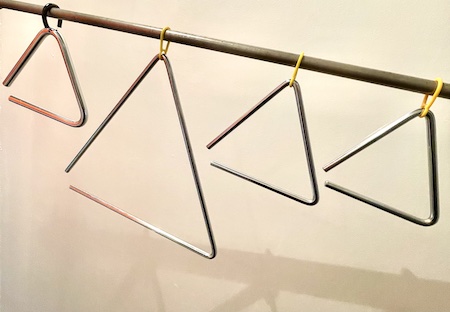
Also « Rites », that came to be around the same time as « Applaus ! », is a sudokist clockwork, built from and expoing the palpable ticking—on, on and away—of time. The core idea was to make a triangle quartet, each triangle ticking like a clock, brushing away seconds, but ‘waveringly’: a sudoku value of e.g. 7 will translate to a tick, followed by six seconds of non-ticks.
I experimented with adding a melodic voice (bass flute) on top of the ticking of the metals, but then removed it again, as it seemed, like with « Applaus! », that the ‘natural‘ form would let the triangles, like the handclaps, run through the full lexicographically ordered list of re-colorations of the initial grid, in this case the sudoku solution featured in the fifth week's K7 sudoku recording of 2020, sudoku202005. To emphasize the ceremonial feel and intention of the bell-like ringing of the triangle 'clocks', I added 9 tuned gongs, a gong for each of the digits. A gong sound (the one corresponding to the first digit in the permutation that determines the rite's coloration) marks the beginning of each of the rites. A performance / installation is to commence with a brief exposition of the initial sequence (1,2,3,...,9) of the nine gong tones.
The sudoku 'ticks' in « Rites » were given the duration of a clock's 'ticks', so they count seconds, i.e., they are passing at five times the speed of the claps in « Applaus ! ». Hence, a full sounding of all colorations of « Rites » would need about five years. It could be quite splendidly set up to pass in a small garden shed, a little temple, a countryside chapel, a cave, far from the drone and rumble of big cities, as a space and place for reflection, meditation, and (why not, for those who want) prayer to whatever god or force.
The reference to human time and clocks is made explicit—in the ‘five years‘ installation version—through a narrative touch: the chime of an old standing clock. For me, it's a sound that strongly evokes the nearly identical chime of the clock in my grandparents' living room, a clock that was carefully regulated, maintained, and wound up according to a strict and very personal daily ritual by my grandfather. He was the keeper of our time, our time's guardian.
The chime of the standing clock will sound at just a few, randomly chosen, moments in the course of the 9! rites.
Though one might still want to argue that basically, the sudokist four clapping hands and the sudokist four clicking triangles, are both instances (“projections“) of the same, say, sudokist meta-piece, the sequencing of the sudoku solutions for the triangles is done in a way different from that used for the clappers in « Applaus ! ». The rites use what I call ‘snake reading the grid‘, as indicated for each of the four triangles in the following picture:
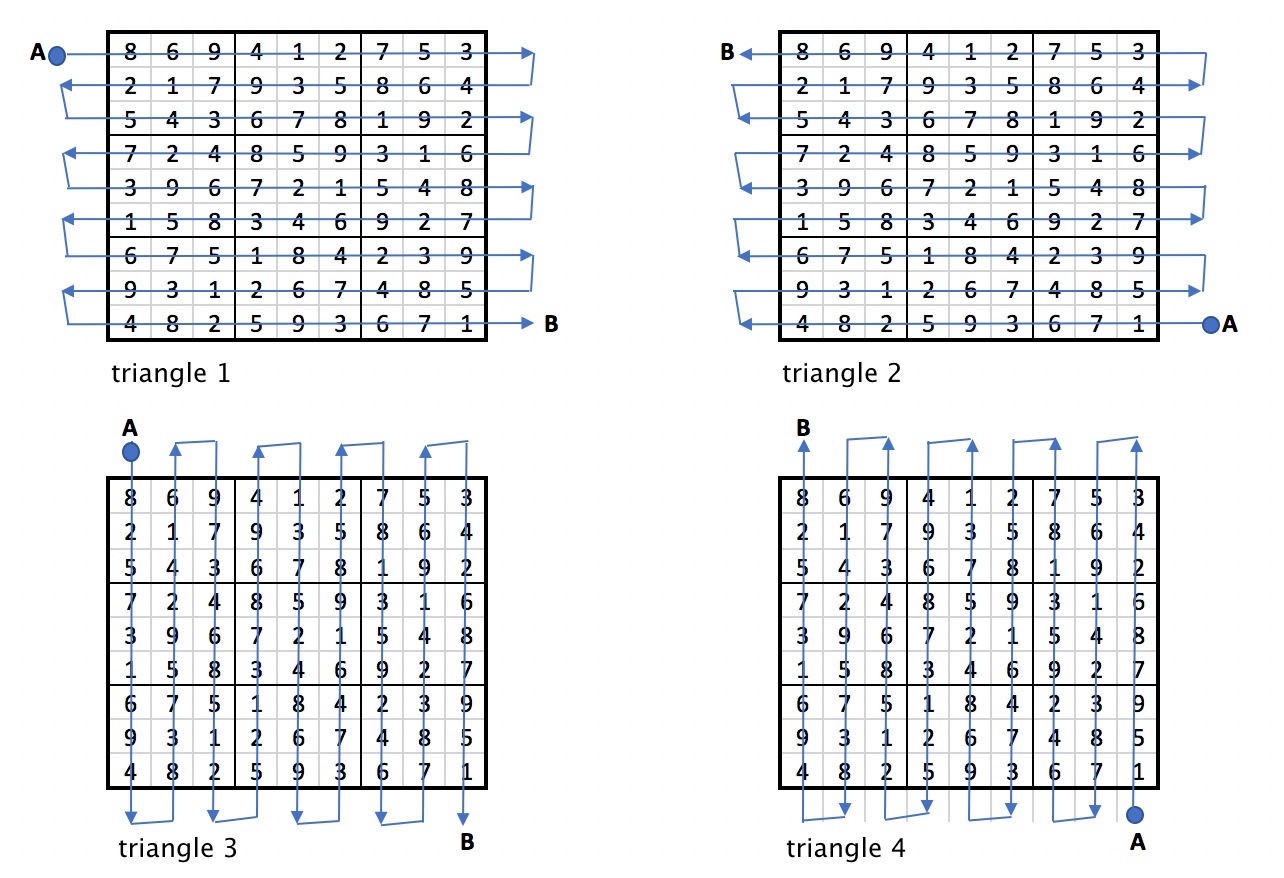
On the digital album you will find 36 of the 362880 rites, all re-colorations of suso #5. They come in 18 pairs, and the overall composition of the ‘runs‘ differs from that in the installation version. For the album tracks I used 2 × 4 differently sounding triangle hits, that I recorded using the triangles in the picture above: there are four open ticks, with a long decay-release time of the note, and there are four muffled ticks. The album starts with two pairs where the triangle sounds are open. The remaining sixteen pairs each use one of the sixteen possible combinations of open and muffled.
...
I recommend lowering the volume when listening to the Rites album. Then, close your eyes. In a quiet space, during still moments, it will almost feel as though droplets of water are endlessly splashing apart on some metallic surface, perfectly in tune with the laws of gravity—and the nature of liquid and solid matter.
...
Each of the 18 pairs is complementary in the following sense: given a sudoku grid S, there is exactly one 'coloration' Sc, such that corresponding digits in the grid add up to 10. Here, as an example, is the first pair of the album, re-coloration nr. 20160 and nr. 342721 ( ** ):
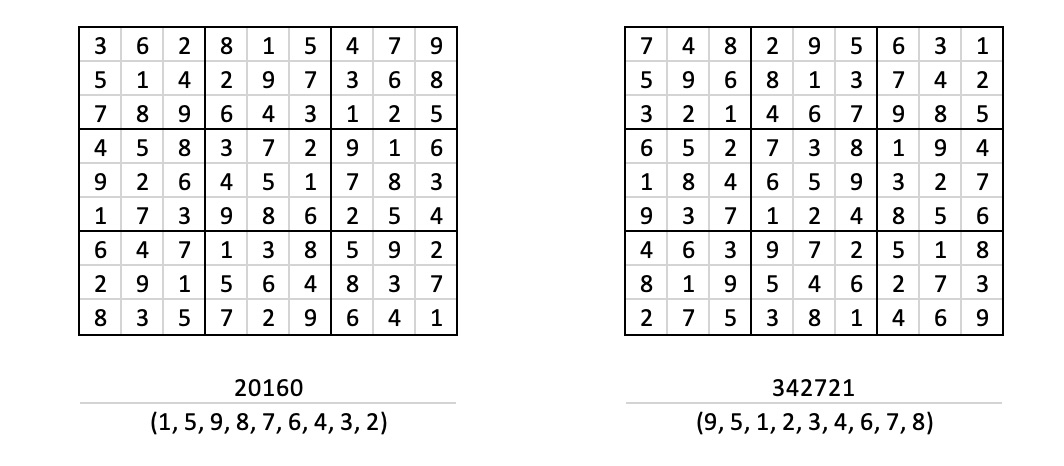
The suso, however, that is read and played, for the odd numbered coloration 342721, is not the one shown in the image, but the one here below, its reflection in the horizontal axis, i.e. the i-th row becomes row number 10-i. 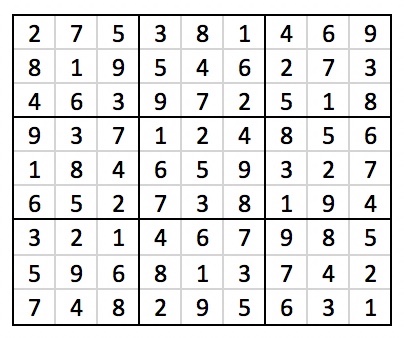 Why that is, will become clear in what follows.
Why that is, will become clear in what follows.
If we think of a suso ‘three dimensionally’ as a set of triples { (i, j, k) }, with i the row number, j the column number, so that { (i, j) } is the grid, then k, the sudoku digit, can be read as the height of a block placed in the cell (i, j). The ‘coloration‘ then says that if { (i, j, k) } is a suso, and σ a permutation of the nine digits (heights), i.e. an element of S9, then also { (i, j, σ(k)) } is a suso. As σ(k) = 10-k actually is a 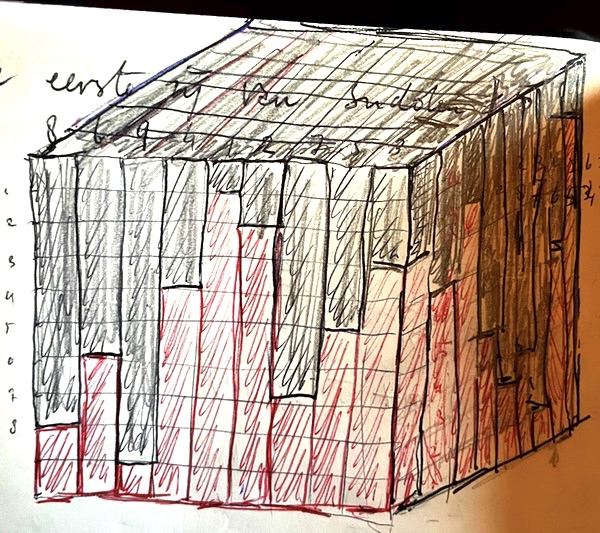 permutation of the nine digits, if { (i, j, k) } is a suso, then so is { (i, j, 10-k) }. And (by reflection in the horizontal axis) also { (10-i, j, 10-k) } is a sosu, so if we turn the 3d-object corresponding to this suso upside down, and put it on top of the 3d-object corresponding to the original suso, they make a perfect fit into one solid block of dimensions 9 × 9 × 10, as sketched in the picture. So that is sort of the fun of having ‘complementary’ colorations.
permutation of the nine digits, if { (i, j, k) } is a suso, then so is { (i, j, 10-k) }. And (by reflection in the horizontal axis) also { (10-i, j, 10-k) } is a sosu, so if we turn the 3d-object corresponding to this suso upside down, and put it on top of the 3d-object corresponding to the original suso, they make a perfect fit into one solid block of dimensions 9 × 9 × 10, as sketched in the picture. So that is sort of the fun of having ‘complementary’ colorations.
I call pairs of suso's { (i, j, k) } and { (10-i, j, 10-k) } ((or, as we'd could also have chosen to reflect the number-grid in the vertical axis, { (i, j, k) } and { (i, 10-j, 10-k) })) 3d-complementary. The 18 rites on the digital album each consists in a 3d-complementary pair in precisely this sense: the suso colored according to permutations that have an odd index in the lexicographic list, were reflected in the horizontal axis. Each pair of runs in the 18 rites on the digital album is such a 3d-complementary pair.
Ten slotte, for live performances, I scored colorations nr. 111111, nr. 222222 and nr. 333333. Players can use their proper set of four pairwise differently tuned triangles; also any set of pairwise differently tuned small gongs, numbered 1 to 9, may be used; finally, whatever old clock's chime is available or can be found, will do.
Read all about Sudokism and Südokaising on the SoundBlog:
(2025, april 18) - A decom-.pomdipem~padopi~dompadé.-posed suso
(2025, march 01) - Full coloration set sudoku solution pieces
(2025, january 23) - ‘War drift’ for violoncello, and other sudoku, latin and costas grids
(2025, january 3) - “Let me show you exactly what you are” (Sudoku 3, for double bass)
(2024, july) - Uit de kast: "I am a Sudokist!"
(2021, september 11) - The Art of K7 :: Südokaising [ii] Time Folds
(2020, march 21) - The Art of K7 :: Südokaising [i]
(2006, april 17-25) - 'sudoku-solution' in 'de nor'
Read about Sudokism and Südokaising on Medium:
(2024, october) - Variations on a Sudoku Solution for Perished Piano
notes __ ::
(*) From the lyrics of 'Paper Hats', track on the album 'Deceit' (1981) by This Heat [ ^ ]
(**) In the lexicographically ordered list < σ1, σ2, ..., σn! > of elements σk of Sn, all pairs of permutations (σk, σn!-k+1) are complementary in this sense, i.e. σk(i) + σn!-k+1(i) = n+1. This 'complementarity' is better understood as an operation (action) on the matrix of the permutation, I will probably come back to that in a future text. [ ^ ]
tags: sudokism, permutations
# .552.